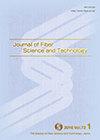Effect of Scouring and Bleaching on Chemical Modification of Cotton Sliver by EB-Induced Graft Polymerization
IF 0.3
4区 工程技术
Q4 MATERIALS SCIENCE, TEXTILES
引用次数: 0
Abstract
: A cotton fabric has high water absorption and good touch, so it has been used as clothes since ancient times. Electron beam (EB) induced graft polymerization is one of the chemical modification methods for polymer materials such as fibers and films. In this study, it was shown that uniform modification can be achieved through EB-induced graft polymerization even with unrefined cotton sliver. The Cotton sliver can be used not only for fabrics but also for knits and nonwoven fabrics and so on. ESR spectroscopy and the degree of grafting showed that the amount of radical generated in the original sliver was smaller than that for the sliver after scouring and bleaching. A more remarkable difference was observed in the amount of active radical that could initiate the graft polymerization. Nevertheless, it was possible to modify the cotton sliver that had not been scoured and bleached through the EB-induced graft polymerization if the graft polymerization could be completed within 90 min. Microprobe Raman spectroscopy revealed that the generated graft chains were uniformly distributed inside the sliver. A comparison of the reactivity of monomers in different dispersion states in water showed that the monomers forming small dispersion units in water tended to have the higher degree of grafting. The diffusion process in which the monomer reaches the active site in the sliver before their disappearance must be key process for the graft polymerization to proceed.煮漂对EB接枝聚合棉条化学改性的影响
:棉布吸水性好,触感好,所以自古以来就被用作衣服。电子束引发接枝聚合是对纤维、薄膜等高分子材料进行化学改性的方法之一。本研究表明,即使是未精制的棉条,EB诱导的接枝聚合也可以实现均匀的改性。棉条不仅可用于织物,也可用于针织品、非织造布等。ESR光谱和接枝度表明,经煮漂后,原棉条中产生的自由基量小于原棉条。在可以引发接枝聚合的活性自由基的量方面观察到更显著的差异。然而,如果接枝聚合可以在90分钟内完成,则可以通过EB诱导的接枝聚合对未经洗涤和漂白的棉条进行改性。微探针拉曼光谱显示,生成的接枝链均匀分布在棉条内部。不同分散状态的单体在水中的反应性比较表明,在水中形成小分散单元的单体往往具有更高的接枝度。单体在消失之前到达银条中的活性位点的扩散过程必须是接枝聚合进行的关键过程。
本文章由计算机程序翻译,如有差异,请以英文原文为准。
求助全文
约1分钟内获得全文
求助全文
来源期刊

Journal of Fiber Science and Technology
Materials Science-Materials Science (miscellaneous)
CiteScore
0.50
自引率
0.00%
发文量
17
 求助内容:
求助内容: 应助结果提醒方式:
应助结果提醒方式:


